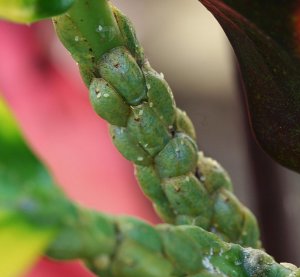fawnridge
Well-Known Member
- 1,430
- 04/07/09
- 49
- 68
First, some observations...
1. For three years I stopped fertilizing the garden. Everyone around me had Croton scale; I had none. This year, I threw down a bag of fertilizer, don't ask why. Now, I have Croton scale on dozens of plants.
2. There doesn't seem to be any rhyme or reason to what's attacked. Even the same variety in different parts of the garden. I have Victoria Gold Bells in three different locations, only one has scale. My Ethel Craig is covered with scale, but only one of the eight Crotons next to it are affected.
3. It's fast. Very fast. Within a week, I'll see a healthy plant get covered with scale.
4. Color, leaf-shape and size, lighting conditions, all have nothing in common with whether or not a plant will be hit.
Okay, what's working...
1. Clippers. Yep, I'm hacking plants back to the branches, cutting off every leaf and letting the plant start over.
2. Poison. I'm using a mix of Organicide and Malathion at the recommend dosage and spraying the affected plants until they are drenched. Repeat every week or two. This seems to kill everything but the plant. The plants I clip back are getting drenched after the clipping.
3. Not yet thinking about replacing the Crotons with another plant, not another Croton, but that time will come.
1. For three years I stopped fertilizing the garden. Everyone around me had Croton scale; I had none. This year, I threw down a bag of fertilizer, don't ask why. Now, I have Croton scale on dozens of plants.
2. There doesn't seem to be any rhyme or reason to what's attacked. Even the same variety in different parts of the garden. I have Victoria Gold Bells in three different locations, only one has scale. My Ethel Craig is covered with scale, but only one of the eight Crotons next to it are affected.
3. It's fast. Very fast. Within a week, I'll see a healthy plant get covered with scale.
4. Color, leaf-shape and size, lighting conditions, all have nothing in common with whether or not a plant will be hit.
Okay, what's working...
1. Clippers. Yep, I'm hacking plants back to the branches, cutting off every leaf and letting the plant start over.
2. Poison. I'm using a mix of Organicide and Malathion at the recommend dosage and spraying the affected plants until they are drenched. Repeat every week or two. This seems to kill everything but the plant. The plants I clip back are getting drenched after the clipping.
3. Not yet thinking about replacing the Crotons with another plant, not another Croton, but that time will come.










